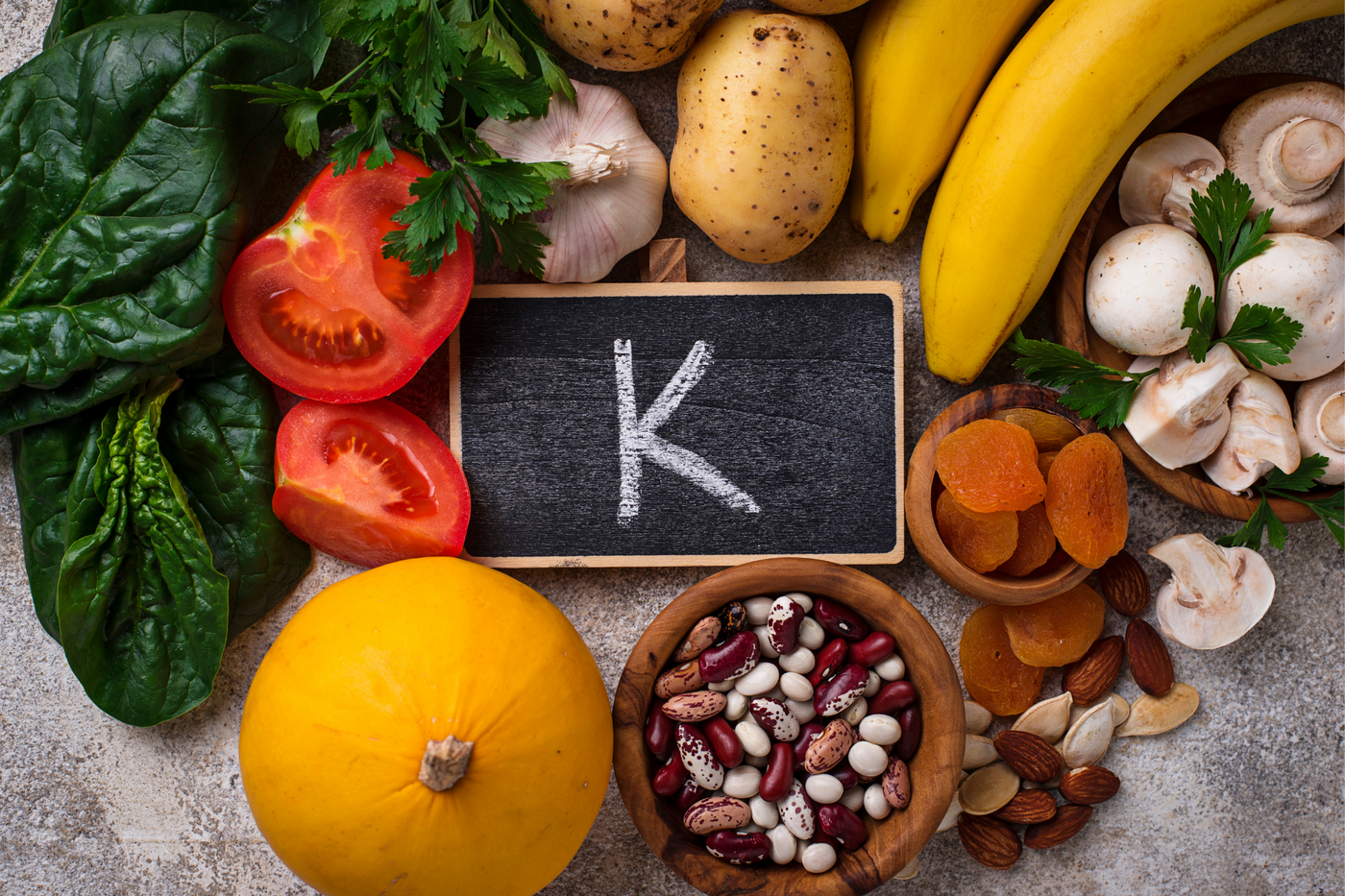Fibro Fix Blog — vitamin d

What is Vitamin K and Why is it Important? 0
By Dr. David M. Brady and Danielle Moyer, MS, CNS
Vitamin A = Eyes.
Calcium = Bones.
What about vitamin K?
Vitamin K doesn’t get as much press as other vitamins, but that does not mean it is less important.
The “K” in vitamin K originates from the Danish word “koagulation”, which translates to “coagulation”. One of the main roles of vitamin K is assisting in blood coagulation. Meaning, if you are bleeding from a cut, vitamin K is a main player in helping the blood clot (or stop) naturally! Through time, we have learned that vitamin K’s importance goes well beyond just blood clotting.
Roles & functions of vitamin K
- Help with blood clotting
- Lowers inflammation in the body, helping with any inflammatory/autoimmune disease
- Gene expression (Properly expressing you genetic code)
- Supports optimal bone health, increasing collagen and calcium content of bones
- Supports teeth/oral health
- Supports cardiovascular health
- Anticancer effects
- Reduces risk of kidney stones
- Prevention or reversal of osteoporosis, which may reduce bone fracture risk
- For men, increased testosterone
Research has found that vitamin K, vitamin D, and vitamin A all work in concert together. For vitamin K to fully display all of its potential benefits, vitamin D and vitamin A must be optimized as well [1].
Effects of low vitamin K levels and/or deficiency:
- Easy bruising and bleeding (nosebleeds, bleeding gums, blood in urine/stool, heavy menstrual bleeding) [2]
- Improper bone mineralization
- Reduced health of joint cartilage, tendons, ligaments
- Suboptimal skin health, elasticity, and overall appearance
- Impaired insulin secretion and increased insulin resistance
- Increased risk of kidney stone formation
- Suboptimal energy production
- Inadequate antioxidant protection in the brain
- Increased severity of cystic fibrosis
- Reduced testosterone production [1]
Supplementation with high doses of standard vitamin E (d-alpha-tocopherol), ranging from 800-1200 IU, has been shown to impair and interfere with vitamin K’s blood clotting ability, whereas excess vitamin A supplementation can interfere with vitamin K absorption [1-2]. Both should be avoided unless specifically advised by your doctor and/or nutritionist.
Vitamin K has many forms
Vitamin K has different forms that can be grouped into three classifications: vitamin K1, vitamin K2, and vitamin K3. We will focus on vitamin K1 and K2, as they are the forms found in supplements and produce the benefits listed above.
Vitamin K1, or phylloquinone:
Vitamin K1 is the most common form of vitamin K in the diet and occurs naturally in certain vegetables, vegetable oils, seeds, and algae [1].
Foods with high vitamin K1 content:
- Kale
- Swiss chard
- Parsley
- Broccoli
- Spinach
- Watercress
- Leaf lettuce (green)
- Soybean oil
- Canola oil
- Olive oil
- Cottonseed oil [2]
The best way to absorb vitamin K1 through the vegetables above is to eat them cooked, blended, or juiced (as opposed to raw), as well as eating them with a source of dietary fat.
Elements that destroy vitamin K in food are exposure to light and hydrogenation (as in hydrogenated oils). Hydrogenated oils are created during industrial cooking, frying, or baking, and will be listed “partially hydrogenated” or “hydrogenated” on the ingredients list of processed foods.
A large portion of the population get their main sources of vitamin K1 from vegetable oils rather than vegetables. When the oils are hydrogenated from fast foods or processed foods, this can lead to low levels of vitamin K in the individual [1].
Vitamin K2, or menaquinones:
Vitamin K2 represents 90% of the total vitamin K stored in our body because a large portion of vitamin K1 gets converted into vitamin K2 for storage.
Vitamin K2 has 14 different forms. They are labeled MK-1 through MK-14. “MK” stands for menaquinone. The most discussed and researched forms are vitamin MK-4 and vitamin MK-7 [1].
Vitamin K2 is technically not a “vitamin” because our bodies can actually produce it themselves. Synthesis can occur through the bacteria in our intestines in a healthy gut environment. It is important to note that if a person uses an antibiotic, this can kill over 70% of the beneficial gut bacteria that normally produces vitamin K2 and extra supplementation may be necessary [4].
Since other animals and fermentation processes can synthesize vitamin K2, we can also find it in foods like:
- Grass fed-meat and liver, fish, and egg yolk
- Yogurt, cheese, sour cream, buttermilk
- Sauerkraut, kimchi, and natto
Certain individuals who have difficulty converting vitamin K1 into vitamin K2 because of age-related changes, certain diseases, genetics, or chronic antibiotic use may particularly benefit from supplementation of vitamin K2. The diseases of concern include osteopenia, osteoporosis, osteoarthritis, and arterial calcification [1].
One will often find both MK-4 and MK-7 in supplements, in addition to vitamin K1. Vitamin MK-7 displays some, but not all of the beneficial effects of MK-4, and has not been proven to be more effective than vitamin K1 or vitamin MK-4. There is also a unique element called geranylgeraniol (GG) which can facilitate more natural production of vitamin K in the body. Some supplements now contain K1 and K2-MK-4 along with GG to ensure that they all work together to promote optimal delivery of vitamin K2 (as MK-4) to tissues supporting normal blood clotting, bone mineralization, and arterial elasticity. [3]. This is good news, as MK-7 is 10 times more expensive than MK-4 per milligram basis [1]. Expensive does not always mean better, and when the hard science is looked at regarding vitamin K metabolism it may be that the marketing on some vitamin K2 sub-types is more hype than reality!

The best approach to optimize vitamin K
Overt vitamin K deficiencies are rare in the United States, but lower than optimal levels are more common [4].
The adequate intake (AI) of vitamin K1 is 90 mcg for women and 120 mcg for men. It has been found that 60-70% of the US does not meet this standard, which some argue is already below what may be necessary for optimal health.
The best recommendation for any age or gender is to get as much vitamin K1 from eating an abundance of leafy greens (or their juices) or healthy oils (such as olive oil) every day.
Humans are adapted to intake up to 1,000 mcg of vitamin K1 daily with no adverse effects [1]. Since it seems improbable that all individuals will achieve this goal via their diet, supplementation of vitamin K1 and/or K2 may be warranted for a large portion of the population.
Vitamin K may be particularly crucial for adolescents going through peak bone development and those of reproductive age. It is also important for older individuals, especially women in peri- and established menopause and men with lower than optimal testosterone levels. Lastly, it is also crucial for those on chronic antibiotic therapy as well as those with severe gastrointestinal malabsorptive disorders (Crohn’s disease, ulcerative colitis, celiac disease, cystic fibrosis, chronic pancreatitis) [1,4].
Anticoagulant drugs, such as warfarin or Coumarin, directly interfere with vitamin K utilization in the body, and large doses of vitamin K may undermine the medication. It is advised for a patient on these drugs to not avoid vitamin K intake, but rather, keep their vitamin K levels consistent at the dietary intake of 90 to 120 mcg/day, avoiding any large fluctuations. Vitamin K intake from food and supplements should be closely monitored with a doctor if you are undergoing anticoagulant therapy [2].
Labs to get your vitamin K levels assessed
If you are curious about your vitamin K levels, there are two scientifically validated functional markers: Uncarboxylated osteocalcin and uncarboxylated Matrix GLA protein [3]. One can also look at whole blood clotting and prothrombin time [4]. Plasma or blood levels are not valid indicators of vitamin K status [3]. Talk to your doctor to see which test may be appropriate and best for you.
The takeaway
Some argue that vitamin K will soon become the “new vitamin D”, where it becomes a household topic and everyone wants to optimize their levels. Many researchers performing reviews on vitamin K call for more research to further clarify its roles in clinical applications [1]. In the meantime, the least we can do is eat our green leafy vegetables! We have vitamin K to thank for that advice. However, a more proactive approach involves the use of a well designed and balances vitamin K supplement, such as Tri-K. Discussing vitamin K supplementation with you functional medicine physician and clinical nutritionist is also suggested.
References:
- Paul CI. Vitamin K. In: Pizzorno, JE, Murray MT, ed. Textbook of Natural Medicine. 5th ed. St. Louis, MO: Elsevier; 2021: 919-947.
- Gropper SS, Smith JL, Carr TP. Advanced Nutrition and Human Metabolism. 7th ed. Boston, MA: Cengage Learning; 2018: 408-415.
- Brady DM, Paul C. Tri-KTM: Three Pathways to Vitamin K. Designs for Health. Published April 2021.
- Hidgon, J. Vitamin K. Linus Pauling Institute: Micronutrient Information Center website. https://lpi.oregonstate.edu/mic/vitamins/vitamin-K. Published 2000. Reviewed August 2014. Accessed July 29, 2021.

Men & Osteoporosis: Women’s World No More 0
With so much education on bone health focused at older women, you might be surprised to learn that men of a certain age are also at high risk for osteoporosis.
Autumn Allergies – Please Pass the Tissues 0
As the cooler weather blows in, it is not uncommon to throw open the windows to air out the home, while simultaneously enjoying crisp cool nights. Unfortunately, for many, coexisting with nature and the fresh air only spawns misery in the form of sneezing, congestion, itchy and watery eyes. Just like spring all over again.
The warm summer months served as a prime growing season for various weeds, which, in full maturity, utilize the cool and breezy fall weather to shed and spread their pollen. Ragweed pollen is among the most common culprits for triggering fall allergies. Releasing pollen from August to November, ragweed is native to a vast majority of American soil, making it virtually impossible to escape.
Similarly, as the fall season progresses, piles of damp leaves and morning dew provide a perfect breeding ground for mold to flourish and release allergenic spores. Mold may not only assault allergy sufferers from outdoors, but can be equally troublesome indoors when the furnace is turned on for the first time, releasing a mass of mold spores that have been hiding among the dirty crevices of the furnace ducts.
QUERCETIN
Supporting the body in its fight against fall allergens becomes the focus of many individuals. Many helpful botanicals can serve this role; however, quercetin excels in this battle. Quercetin is known as a bioflavonoid and is prevalent within apples, onions, grapefruit, red wine, and black and green teas. It is particularly useful in supporting the mucus membranes during exposure to various fall allergens. Mucous membranes are a significant part of our respiratory system and help to protect the delicate cells of the respiratory tract from invaders. Pollen and mold spores are deemed unwelcome invaders that trigger a cascade of events intended to eliminate or neutralize the invaders. This series of events often results in a runny, itchy nose, sneezing, watery eyes and nasal congestion. Quercetin has been relied upon for centuries to help the mucus membranes respond appropriately to allergens by acting as a mediator and helping the body’s natural defense system interact with the allergens in a healthy way. Specifically, quercetin focuses on aiding the white blood cells responsible for transmitting messages and releasing chemicals in response to allergens. Histamine is one chemical released by white blood cells during allergen exposure, and it is responsible for the plethora of annoying signs that follow. Quercetin helps white blood cells react to allergens with a healthy histamine response. It is also useful in supporting the respiratory tract, so it can maintain clear air passage during allergen exposure. So as the weather turns cooler, quercetin may be something to look forward to just as much as pumpkins and scarecrows.
MOLD AND VITAMIN D
Mold allergies are particularly complicated. In apparently healthy individuals, seasonal mold spores may not be any more bothersome than weed pollen, but in other individuals, mold exposure can create chaos in the respiratory tract.
Aspergillus fumigatus is the most frequently encountered fungus both in the home and outdoors. The cells of the respiratory tract act as the fist line of defense, explaining why their health is so important during exposure to mold. Vitamin D can play a significant role in supporting the respiratory tract so it can respond to mold spores in a healthy way. Researchers have discovered that mold spores have the unique ability to identify and claim possession of vitamin D receptors in the airway. Therefore, maintaining adequate vitamin D levels is important so that empty vitamin D receptors are not available for mold spores to possess. Additionally, adequate vitamin D can help the body maintain a healthy inflammatory response to mold exposure. Unfortunately, vitamin D deficiencies are notorious among individuals and replenishing a less-than-optimal vitamin D level can take time. Therefore, it is advantageous to try to attain optimal vitamin D levels prior to the fall season in order to offer the body full support against allergens.
Many botanicals and nutrients can support the health of mucus membranes and the respiratory tract during allergy season. However, quercetin and vitamin D, in addition to a healthy diet that includes plenty of fresh fruits and vegetables, are foundational in maintaining healthy responses to these seasonal invaders.
Sources
Hattori et al. (2013). Quercetin inhibits transcriptional up-regulation of histamine H1 receptor via suppressing protein kinase C-δ/extracellular signal-regulated kinase/poly(ADP-ribose) polymerase-1 signaling pathway in HeLa cells. International Immunopharmacology. 15(2):232-9. doi. 10.1016/j.intimp.2012.12.030.
Weng et al. (2012) Quercetin is more effective than cromolyn in blocking human mast cell cytokine release and inhibits contact dermatitis and photosensitivity in humans. PLoS ONE. 7(3): e33805. doi:10.1371/journal.pone.0033805
Sakai-Kashiwabara, M. and Asano, K. (2013). Inhibitory action of quercetin on eosinophil activation in vitro. Evidence-Based Complementary and Alternative Medicine. Article ID 127105, 7 pages, 2013. doi:10.1155/2013/127105
Joskova, M., Franova, S., and Sadlonova, V. (2011). Acute bronchodilator effect of quercetin in experimental allergic asthma. Bratislavske Lekarske Listy. 112(1):9-12.
Li et al. (2015). Activation of vitamin D regulates response of human bronchial epithelial cells to Aspergillus fumigatus in an autocrine fashion. Mediators of Inflammation, 2015, 208491. http://doi.org/10.1155/2015/208491
